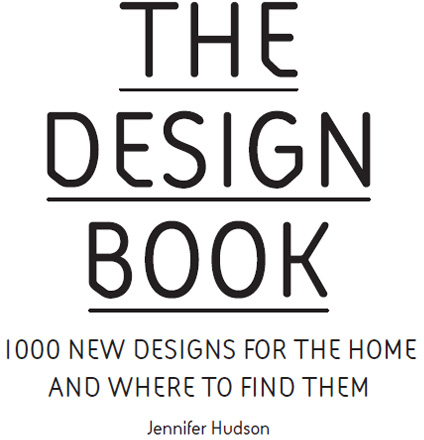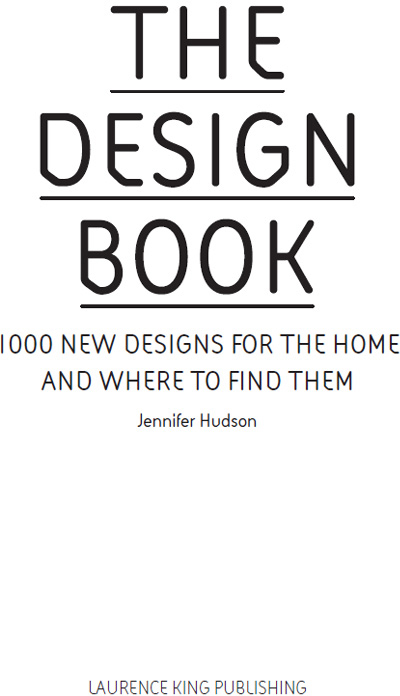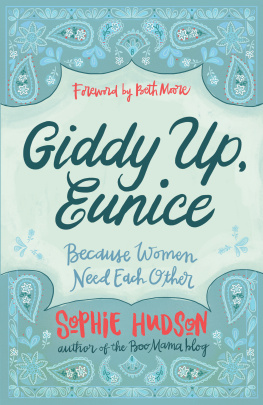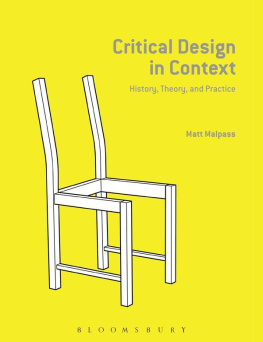Hudson - The design book: 1000 new designs for the home and where to find them
Here you can read online Hudson - The design book: 1000 new designs for the home and where to find them full text of the book (entire story) in english for free. Download pdf and epub, get meaning, cover and reviews about this ebook. City: London, year: 2013, publisher: Laurence King Publishing, genre: Romance novel. Description of the work, (preface) as well as reviews are available. Best literature library LitArk.com created for fans of good reading and offers a wide selection of genres:
Romance novel
Science fiction
Adventure
Detective
Science
History
Home and family
Prose
Art
Politics
Computer
Non-fiction
Religion
Business
Children
Humor
Choose a favorite category and find really read worthwhile books. Enjoy immersion in the world of imagination, feel the emotions of the characters or learn something new for yourself, make an fascinating discovery.
- Book:The design book: 1000 new designs for the home and where to find them
- Author:
- Publisher:Laurence King Publishing
- Genre:
- Year:2013
- City:London
- Rating:4 / 5
- Favourites:Add to favourites
- Your mark:
- 80
- 1
- 2
- 3
- 4
- 5
The design book: 1000 new designs for the home and where to find them: summary, description and annotation
We offer to read an annotation, description, summary or preface (depends on what the author of the book "The design book: 1000 new designs for the home and where to find them" wrote himself). If you haven't found the necessary information about the book — write in the comments, we will try to find it.
Hudson: author's other books
Who wrote The design book: 1000 new designs for the home and where to find them? Find out the surname, the name of the author of the book and a list of all author's works by series.
The design book: 1000 new designs for the home and where to find them — read online for free the complete book (whole text) full work
Below is the text of the book, divided by pages. System saving the place of the last page read, allows you to conveniently read the book "The design book: 1000 new designs for the home and where to find them" online for free, without having to search again every time where you left off. Put a bookmark, and you can go to the page where you finished reading at any time.
Font size:
Interval:
Bookmark:

 Candleholder, Valencia Jaime Hayon Crystal glass, sandblasted by hand H: 23.4cm (9in) Diam: 10.6cm (4in) Gaia & Gino, Turkey www.gaiagino.com
Candleholder, Valencia Jaime Hayon Crystal glass, sandblasted by hand H: 23.4cm (9in) Diam: 10.6cm (4in) Gaia & Gino, Turkey www.gaiagino.com
 Published in 2013 by Laurence King Publishing Ltd 361363 City Road, London, EC1V 1LR, United Kingdom T +44 (0)20 7841 6900 F + 44 (0)20 7841 6910 www.laurenceking.com Text 2013 Laurence King Publishing Ltd All rights reserved. No part of this publication may be reproduced or transmitted in any form or by any means, electronic or mechanical, including photocopying, recording or any information storage or retrieval system, without permission from the publisher. A catalogue record for this book is available from the British Library. ISBN: 978-1-78067-099-7 Design: Eleanor Ridsdale Picture research: Fredrika Lkholm Printed in China Front cover: Johnny B. Butterfly lighting, Ingo Maurer (see p. 68) Acknowledgements I would like to dedicate The Design Book to Laurence King, who has shown me so much support over the years, and to thank the following people for their invaluable help in the making of this book: all the designers featured, especially those who I interviewed and who took the time to give such interesting replies to my questions; Eleanor Ridsdale for her patience and skill in not only organizing over 1000 designs into some kind of order but also in making the pages look good as well; Jodi Simpson, my editor, for her keen eye and expertise and John Jervis for his copy-editing, as well as our production department here at LKP for getting everything into a publishable state. 68) Acknowledgements I would like to dedicate The Design Book to Laurence King, who has shown me so much support over the years, and to thank the following people for their invaluable help in the making of this book: all the designers featured, especially those who I interviewed and who took the time to give such interesting replies to my questions; Eleanor Ridsdale for her patience and skill in not only organizing over 1000 designs into some kind of order but also in making the pages look good as well; Jodi Simpson, my editor, for her keen eye and expertise and John Jervis for his copy-editing, as well as our production department here at LKP for getting everything into a publishable state.
Published in 2013 by Laurence King Publishing Ltd 361363 City Road, London, EC1V 1LR, United Kingdom T +44 (0)20 7841 6900 F + 44 (0)20 7841 6910 www.laurenceking.com Text 2013 Laurence King Publishing Ltd All rights reserved. No part of this publication may be reproduced or transmitted in any form or by any means, electronic or mechanical, including photocopying, recording or any information storage or retrieval system, without permission from the publisher. A catalogue record for this book is available from the British Library. ISBN: 978-1-78067-099-7 Design: Eleanor Ridsdale Picture research: Fredrika Lkholm Printed in China Front cover: Johnny B. Butterfly lighting, Ingo Maurer (see p. 68) Acknowledgements I would like to dedicate The Design Book to Laurence King, who has shown me so much support over the years, and to thank the following people for their invaluable help in the making of this book: all the designers featured, especially those who I interviewed and who took the time to give such interesting replies to my questions; Eleanor Ridsdale for her patience and skill in not only organizing over 1000 designs into some kind of order but also in making the pages look good as well; Jodi Simpson, my editor, for her keen eye and expertise and John Jervis for his copy-editing, as well as our production department here at LKP for getting everything into a publishable state. 68) Acknowledgements I would like to dedicate The Design Book to Laurence King, who has shown me so much support over the years, and to thank the following people for their invaluable help in the making of this book: all the designers featured, especially those who I interviewed and who took the time to give such interesting replies to my questions; Eleanor Ridsdale for her patience and skill in not only organizing over 1000 designs into some kind of order but also in making the pages look good as well; Jodi Simpson, my editor, for her keen eye and expertise and John Jervis for his copy-editing, as well as our production department here at LKP for getting everything into a publishable state.
But, once again, above all I would like to thank Fredrika Lkholm, without whose advice, hard work and patience this book would not have been possible. Well, Fredrika, I think its now time for a mojito, dont you? JH CONTENTS INTRODUCTION Interviewed on the eve of her thought-provoking 2008 exhibition Design and the Elastic Mind, Paola Antonelli, Senior Curator of Architecture and Design at the Museum of Modern Art, New York, spoke of the relevance of designers today: I believe designers are so important to society because they are like the worms that eat the earth and then digest and expel it as something fertile to make the terrain more fruitful. They are great synthesizers, very curious of all different viewpoints. The best designers enjoy design as an affirmation of life and a way to discover the world. And they render back to the world what they have learned. The show gathered together over 200 objects, projects and concepts that explored the relationship between design and science on every scale from the microscopic to the cosmological, from nanodevices to vehicles, from appliances to interfaces, and from pragmatic solutions for everyday use to provocative ideas meant to influence our future choices.
The aim was to focus on the designers ability to grasp momentous changes in technology and social mores and convert them into products and systems that we as consumers can understand and use. More than ever before, the significance we give to design in our everyday life is becoming apparent. Designers may not be able to change the world, but they will, as interpreters of innovation, increasingly become the catalyst for that change. Design is a broad-ranging discipline that today is recognized not only in the objects that you will find in the pages that follow but in its ability to build bridges between invention and real life. The word design has for too long been contaminated by the notion of decoration rather than what it could be: a vehicle for cultural, social and economic development. The strength of the designer is in his or her ability to take many different sources and ideas and amalgamate them into an object, scenario or service that has a clear intention and function.
Over recent years, with the advent of design thinking and critical designthe former redefining what it means to be a good designer to include systems and strategies as well as enhanced skills in observation, analysis and communication; the latter using designed artefacts as an embodied critique or commentary on existing values, morals and practices in culturethe designers intellectual focus is no longer solely on producing tangible things but on applying thought processes to ethical, social, environmental or humanitarian problems. The designers purpose is to achieve the goals that are assigned to him or her, whether that be in the products that surround us, in technological innovations, in information processing or in a broader sense, sitting on panels to bring their elastic minds to advise on such concerns as health, poverty, aging or long-term unemployment. The designers role is to use the means available in a way that is relevant, logical, economical, elegant, expressive of us and the current zeitgeist, and most importantly, given the environmental crisis we are suffering, that champions sustainability. The definition of design is changing. It is much more expansive and fluid than it used to be, and it comes with increased responsibility. For designers involved primarily with the process of producing objects, it is now no longer enough to make something that looks good and functions; they also have to create products that last, have the minimum impact on the environment, appeal to our sentiment and use technology and materials in an ingenious and imaginative way.
At the beginning of the 1970s, the designer Victor Papanek wrote in his rabble-rousing book Design for the Real World: There are professions more harmful than industrial design, but only a few.this book and emphasized in the telling responses of the designers interviewed on being asked, for example, what they consider to be the main challenges currently facing a designer, what they understand as the definition of sustainable design and whether design can contribute to social change. The atmosphere of the 2012 Salone (the last before this publication went to print) was subdued, demure and conservative, reflecting the austerity of the times and the realization that consumer demand is for less rather than more. The end users of design products, instead of choosing many objects of a kind, are selecting just one that resonates emotionally and that they will want to keep for a long time. The most talked-about exhibitions were not the ones showcasing jaw-dropping furniture aimed at the luxury market but those that highlighted the need for design to be accessible to and understandable by the person in the street; these exhibitions addressed the growing interest in collaborative design, hacked design (the contemporary concept of appropriation, alteration and transformation), and opensource design (the free-sharing of technological information with its concomitant need for transparency and plurality), and emphasized the processes that lead up to the finished object. The design agenda for the foreseeable future will be beset by many challenges and complex issues. But with the growing acknowledgement of designers innate creative attitude, their ability to work in teams, their multidisciplinarian and experimental minds, along with the potential they have, in brain-storming with other disciplines and organizations, to tackle societal problems, this is a period of unparalleled opportunities.
Next pageFont size:
Interval:
Bookmark:
Similar books «The design book: 1000 new designs for the home and where to find them»
Look at similar books to The design book: 1000 new designs for the home and where to find them. We have selected literature similar in name and meaning in the hope of providing readers with more options to find new, interesting, not yet read works.
Discussion, reviews of the book The design book: 1000 new designs for the home and where to find them and just readers' own opinions. Leave your comments, write what you think about the work, its meaning or the main characters. Specify what exactly you liked and what you didn't like, and why you think so.
















